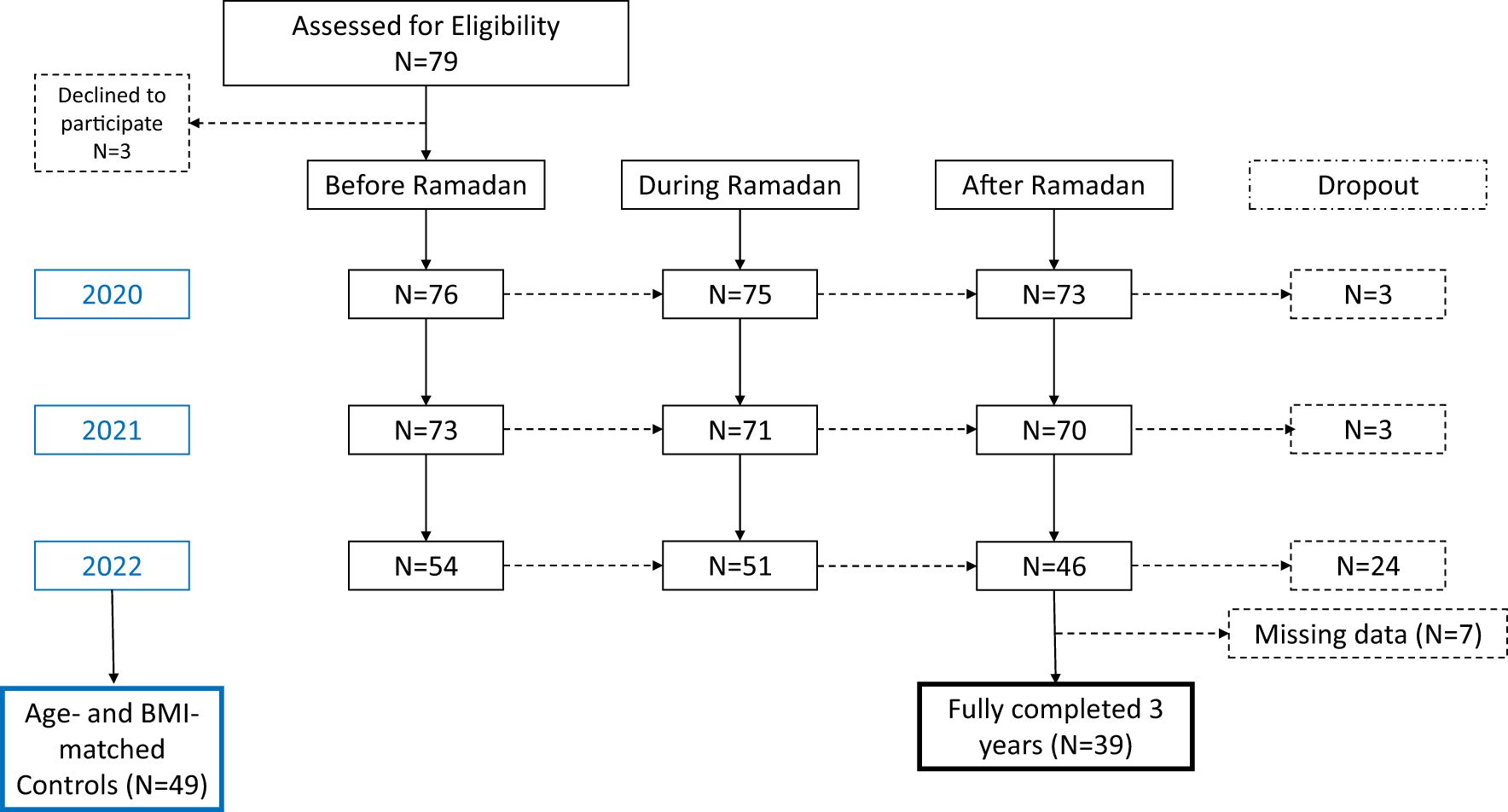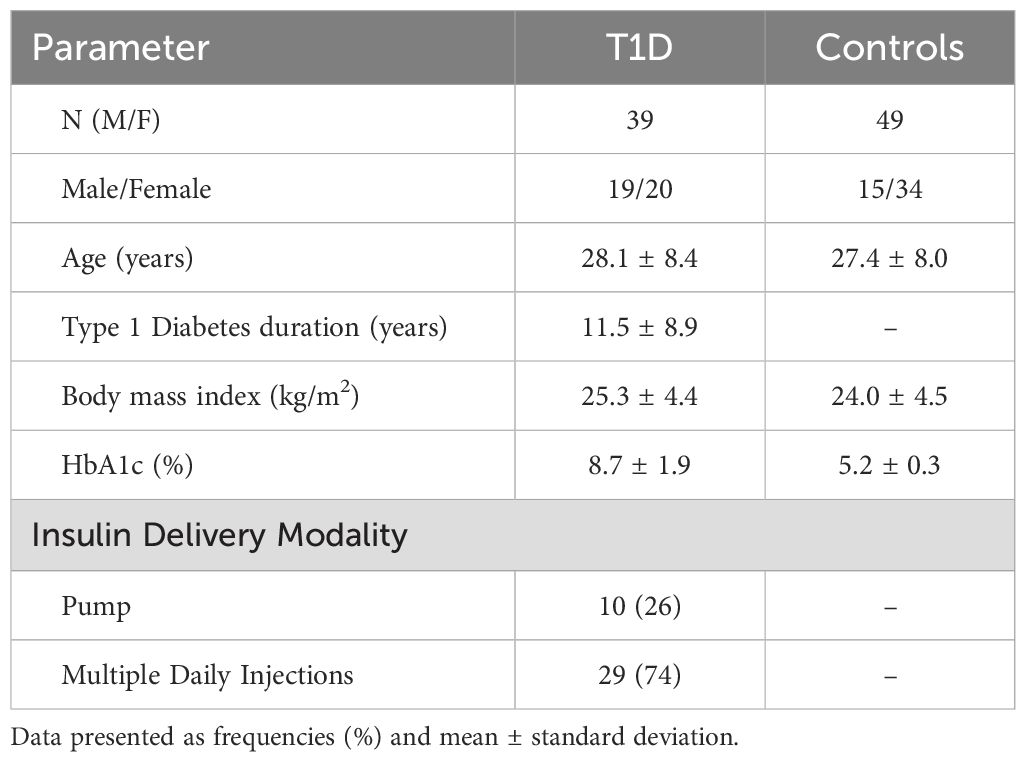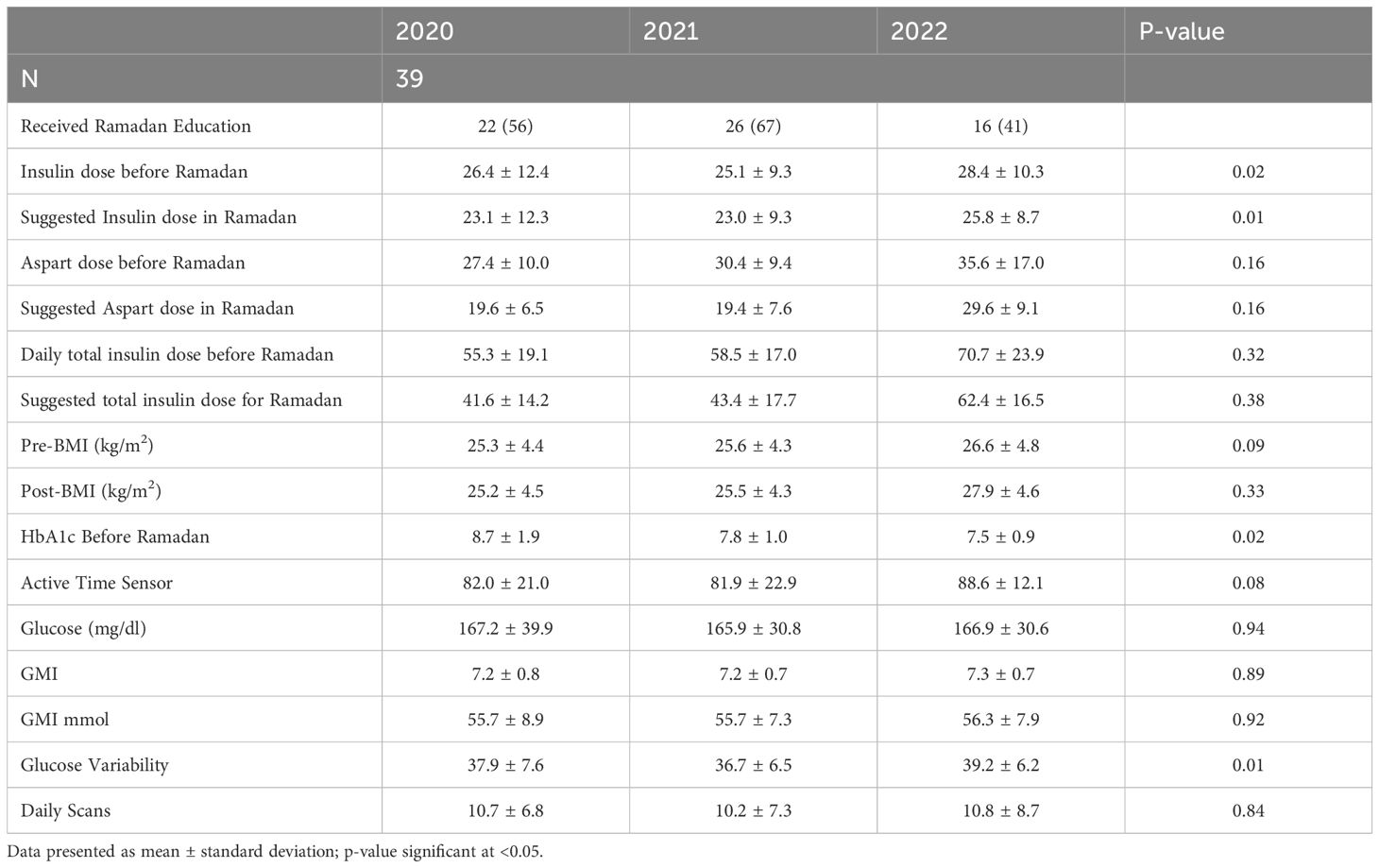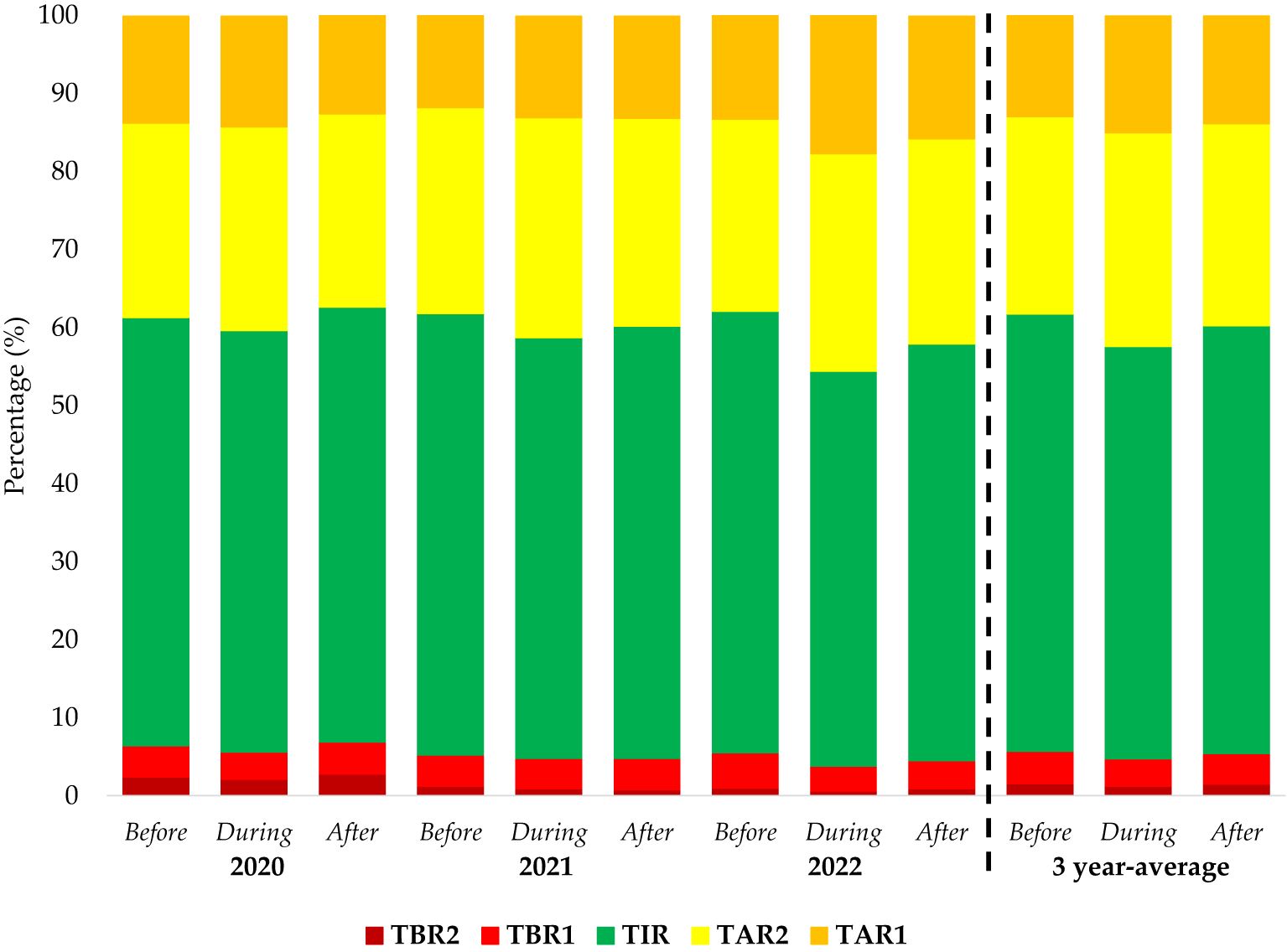- 1Division of Endocrinology, Department of Internal Medicine, College of Medicine, King Saud University, Riyadh, Saudi Arabia
- 2Dallah Hospital, Diabetes Center, Riyadh, Saudi Arabia
- 3Division of Endocrinology, Department of Internal Medicine, Salmaniya Medical Complex, Manama, Bahrain
- 4Department of Internal Medicine, King Saud University Medical City, King Saud University, Riyadh, Saudi Arabia
- 5University Diabetes Center, King Saud University Medical City, Riyadh, Saudi Arabia
- 6Division of Endocrinology, Diabetes & Metabolism, The Johns Hopkins University, Baltimore, MD, United States
Background: Adults with type 1 diabetes (T1D) who fast during Ramadan remain a severely understudied population in terms of changes in glycemic control, making evidence-based recommendations for insulin adjustments difficult in this age-group. To fill this gap, we aimed to prospectively observe the changes in glycemic control of young adults with T1D who fast during Ramadan.
Methods: In this 3-year prospective study, we enrolled participants with T1D with flash glucose monitoring (FGM) data during the Ramadan periods of 2020-2022. CGM data for 4 weeks before, during, and after Ramadan were collected and analyzed. A sub-cohort of age-matched non-DM participants (N=49) who fasted during the Ramadan of 2022 were included for comparison.
Results: A total of 76 participants were enrolled, of whom only 39 (19 males and 20 females, mean age 28.1 ± 8.4 years) completed the three-year follow-up. The mean duration of diabetes among these participants was 11.5 ± 8.9 years. Ten (26%) patients were on insulin pump, and 22 (56%) patients received Ramadan-focused education at baseline. Pooled glycemic trends during Ramadan showed two main abnormal glucose spikes: after Iftar (between 16:00-18:00 and 18:00-20:00), with a difference of 15.5mg/dL, and after Suhoor (between 0:00-2:00h to 4:00-6:00), with a difference of 18.8mg/dL. These abnormal glycemic indices persisted a month after Ramadan. In parallel, these glucose spikes were also observed in non-DM participants, but remained within normal limits.
Conclusions: Ramadan fasting among adults with T1D in SA is associated with deterioration in glycemic control, with the highest glucose spikes observed after Iftar and Suhoor. These hyperglycemic episodes were most prominent during Ramadan and persisted for at least a month after. The present real-time evidence warrants the need to review insulin adjustments in this understudied group, focusing on high risk patients with T1D, including those with history of overindulgent behavior during Ramadan.
1 Introduction
Ramadan is a holy Islamic month during which Muslims observe fasting from dusk until dawn and abstain from food or drink (1). Suhoor, the pre-dawn meal, is the meal consumed before fasting begins, while Iftar is the meal that marks the moment to break the fast at sunset. While intermittent fasting has been shown to offer several benefits (2, 3), it differs from Ramadan fasting in terms of flexibility of fasting days, the latter being stricter as it has to be implemented for a month. Ramadan in Saudi Arabia (SA) is associated with extravagant changes in lifestyle and eating habits; people tend to consume larger portions, including higher consumption of traditional sweets and sweetened beverages which are culturally driven (4–6). Furthermore, sleeping patterns are reversed during Ramadan in SA, resulting in lower physical activity and higher levels of evening cortisol, leading to a paradoxical increase in insulin resistance (7, 8).
For patients with type 1 diabetes (T1D) who choose to fast during Ramadan, as they need to re-adjust insulin doses and timing to minimize the risk of abnormal glycemic changes (9). Moreover, because of the long duration of absolute fasting particularly during summer, additional risks should be considered in patients with T1D, including dehydration, hypoglycemia, and possibly an increased risk of diabetic ketoacidosis (10–12). Despite medical and religious exemptions, a considerable number of T1D patients insist on fasting (1, 13). An epidemiological study across several Muslim countries estimated that 42.8% of Muslims with T1D fast for ≥ 15 days and this was highest in SA at 71.6% (12). A recent survey that included T1D patients and conducted during the coronavirus pandemic found that 71.1% of respondents intended to fast (14). However, only 26.8% managed to fast for the full month, while 45% fasted for more than 21 days. Additionally, 60.7% of participants reported hypoglycemia episodes (14). Several guidelines recommended against fasting during Ramadan for high-risk T1D patients due to lack of available evidence (9, 10, 15). Nevertheless, some studies have shown that it can be safely accomplished in selected patients (16, 17).
Novel technologies seem to provide promising benefits for T1D patients fasting during Ramadan (9, 15). Real-time continuous glucose monitoring (RT-CGM) and flash glucose monitoring systems (FGM) provide comprehensive evaluation of glucose measurements and variability, enabling patients and healthcare professionals to make better-informed decisions (18–23). Additionally, insulin pumps may help individuals with T1D maintain better clinical outcomes (13, 24). Despite the high prevalence of fasting during Ramadan among patients with T1D, there remains a significant gap in the understanding of the impact of this type of fasting on glycemic control, notably among adults with T1D. To fill this gap, we examined the changes in glycemic control among adult patients with T1D who attempted to fast before, during, and after Ramadan and how these changes may have differed from the glycemic changes in non-T1D individuals.
2 Methods
2.1 Study design and participants
This is a real-world observational study that initially included 79 outpatients with T1D who had FGM data during 4 weeks pre-Ramadan, 4 weeks during Ramadan, and 4 weeks post-Ramadan during 2020, 2021 and 2022, at the diabetes clinics of King Saud University Medical City (KSUMC), Riyadh, Saudi Arabia. The inclusion criteria for the study were patients with T1D, aged ≥15 years, who intended to fast during one or more of the Ramadan periods of the three years of the study, and had available FGM data. We excluded patients with T2D, patients with T1D who didn’t attempt fasting during Ramadan or with no FGM data during Ramadan in any of the study periods. Moreover, 49 healthy individuals without diabetes were included in Ramadan 2022. The participants without diabetes were recruited from hospital staff and patients’ companions who consented to wear the sensor for Two weeks during Ramadan 2022 and share their data for the study. Demographic and clinical data such as age, gender, medications, comorbidities, duration of diabetes, HbA1c, and the status of receiving focused-Ramadan education were extracted from the electronic medical records for all participants with T1D. The total fasting hours per day during Ramadan can vary within a year and from year to year. However, the fasting hours during the three study years were around 14.5 hours per day starting at around 04:00 h and ending at around 18:30 h. By the end of the study, 39 participants (19 males and 20 females) remained and were included for analysis (see Figure 1). It is worthy to note that the sudden drop of participants in the last year (2022) was primarily due to the limited availability of sensors, and not necessarily due to dropouts. The study was approved by the institutional review board College of Medicine, King Saud University Riyadh, Saudi Arabia (Ref 21/0439/IRB).
2.2 Glycemic measures using flash glucose monitoring
All participants used the first generation Freestyle Libre 14-day System (Abbott Diabetes Care, Alameda, CA) which is a factory-calibrated flash glucose monitoring sensor with a mean absolute relative difference of 11.4% (25). In this study, we utilized CGM glycemic metrics with their widely accepted definitions including average sensor glucose, glucose management indicator (GMI), time in range (TIR) (i.e. glucose: 70–180 mg/dl), time above range level 1 (TAR-1) (i.e. glucose: 181–250 mg/dl), TAR level 2 (TAR-2) (i.e. glucose: >250 mg/dL), time below range level 1 (TBR-1) (i.e. glucose: 54–70 mg/dl), TBR level 2 (TBR-2) (i.e. glucose: <54 mg/dl), glycemic variability, as measured by the coefficient of variation (CV), sensor active time, and the number of daily scans, which were obtained from the Freestyle LibreView platform (26).
2.3 Assessment of glycemic outcomes
The following CGM metrics were evaluated in all the study participants at 4 weeks pre-, 4 weeks during, and 4 weeks post-Ramadan: Average sensor glucose, GMI, TIR, TAR-1, TAR-2, TBR-1, TBR-2, sensor active time, and the number of daily scans. Average sensor glucose throughout the day during each of the study periods, pre-, during, and post-Ramadan, were analyzed by looking at the patterns and trends of sensor average glucose changes during the day hours and postprandial hours. For controls (individuals without diabetes), similar CGM metrics were only reported during the month of Ramadan. For this group, sensor average glucose throughout the day during Ramadan of 2022 was analyzed by looking at the patterns and trends of sensor average glucose changes during the day hours and postprandial hours. Moreover, laboratory HbA1c within the normal range were required from this group at enrollment.
2.4 Statistical analysis
Analyses were conducted using SPSS software version 28.0 Descriptive statistics, such as mean ± SD for continuous variables and frequencies and percentages for categorical variables, were reported. Repeated measures analysis of variance (ANOVA) was used to compare differences over time. The estimated marginal means and estimated differences from the model were reported as the estimated mean with a 95% confidence interval (CI). All reported p-values are two-tailed, and p<0.05 was considered statistically significant.
3 Results
3.1 Baseline characteristics
The study included a total of 39 T1D participants out of 79 who started in 2020, with 20 (51%) of them being female. The mean age of the participants was 28.1 ± 8.4 years, and the mean duration of diabetes was 11.5 ± 8.9 years. Additionally, 10 (26%) participants were on insulin pump, and 22 (56%) had medical record documentation that they received Ramadan-focused education since 2020. Complete CGM data for all three years of the study was available for all participants. Table 1 presents the baseline characteristics and number of participants with T1D. Moreover, the study included 49 age-and BMI-matched participants (34 females or 69%). The participants had a mean age of 27.4 ± 8.0 years. The mean BMI was 24.0 ± 4.5 kg/m2, and the mean HbA1c was 5.2 ± 0.3%.
3.2 Glycemic indices overtime in people with T1D
A comparison of glycemic metrics across the three years of the study period is shown in Table 2. Insulin doses received before and during Ramadan were highest in 2022 as compared to previous years (p-values 0.02 and 0.01, respectively). There were no significant differences observed over time in terms of Aspart use, daily and suggested insulin doses before and during Ramadan, ICR as well as pre- and post-BMI over time. In terms of glycemic indices, mean HbA1c was worst before Ramadan of 2020 (8.7 ± 1.9) for all participants, which was significantly higher than successive years (p=0.02). On the other hand, mean glucose variability was highest in 2022 as compared to previous years (p=0.01). The rest of the glycemic indices were comparable over time (Table 2).
Figure 2 shows the mean glycemic pattern of T1D participants before, during and after Ramadan for each year while Figure 3 shows the pooled data for 3 successive Ramadan. In both figures, 2 abnormal glucose spikes have been consistently observed overtime and in pooled analysis, all of which occurred during the period of Ramadan. In the pooled data (Figure 3) before Ramadan, the two-hour time bucket with the lowest average glucose level was observed at 10:00-12:00 h (159.2 ± 26.2), whereas the highest average glucose level was observed at 22:00-24:00 h [176.1 ± 27.4] (not mentioned in table). During Ramadan, the lowest average glucose level was observed at 14:00-16:00 h (157.8 mg/dL ± 25.8). The highest average glucose levels were observed after Iftar at 20:00-22:00 h (185.5 ± 27.6), and after Suhoor at 4:00-6:00 h (191.1 ± 27.1). Glycemic trends during Ramadan showed that the highest glucose spike occurred after Iftar, between 16:00-18:00 h and 18:00-20:00 h, with a difference value of 15.5 mg/dL and after Suhoor (between 0:00-2:00h to 4:00-6:00), with a difference of 18.8mg/dL (not shown tables). Glycemic values before, during and after Ramadan for each successive year are presented in Supplementary Table S1.
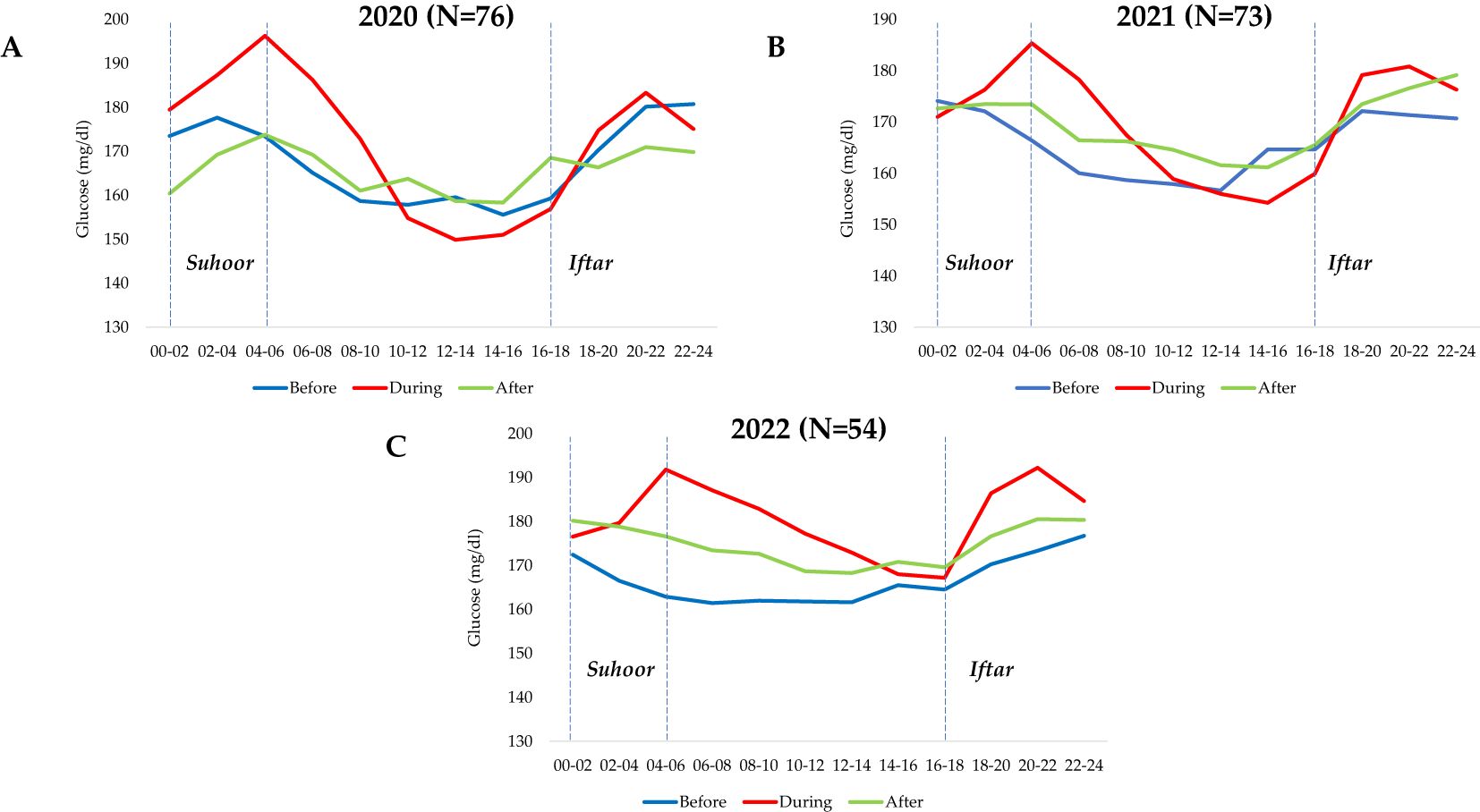
Figure 2. Average 24-hour glycemic pattern of T1D participants before, during and after Ramadan (2020-2022). (A) 2020. (B) 2021. (C) 2022.
With respect to other CGM indices, no significant differences were seen in TAR1, TAR2, TIR, TBR1 and TBR2 before, during and after Ramadan of the years 2020 and 2021. In 2022 however, TAR1 and TAR2 were observed to be significantly higher during Ramadan than before and after (p-values 0.008 and 0.007, respectively). In parallel, TIR and TBR1 were also significantly lower during the Ramadan as compared to before and after (p-values 0.001 and <0.001, respectively), with TBR2 during Ramadan also being significantly lower only during before Ramadan of 2022 (p=0.02) (Supplementary Table S2). Pooled time indices showed no significant differences. Time in ranges over time were presented as Figure 3.
3.3 Impact of Ramadan fasting on glycemic indices in individuals without diabetes during Ramadan
Figure 4 shows the glycemic indices of control participants during the Ramadan of 2022. The lowest average glucose level was observed at 16:00-18:00 h (85.8 ± 7.8). The highest average glucose level after Iftar was observed at 18:00-20:00 h (103.6 ± 10.7), and the glucose change between the lowest and highest average glucose was 17.8 mg/dL (16.1 to 19.5) (Supplementary Table S1).
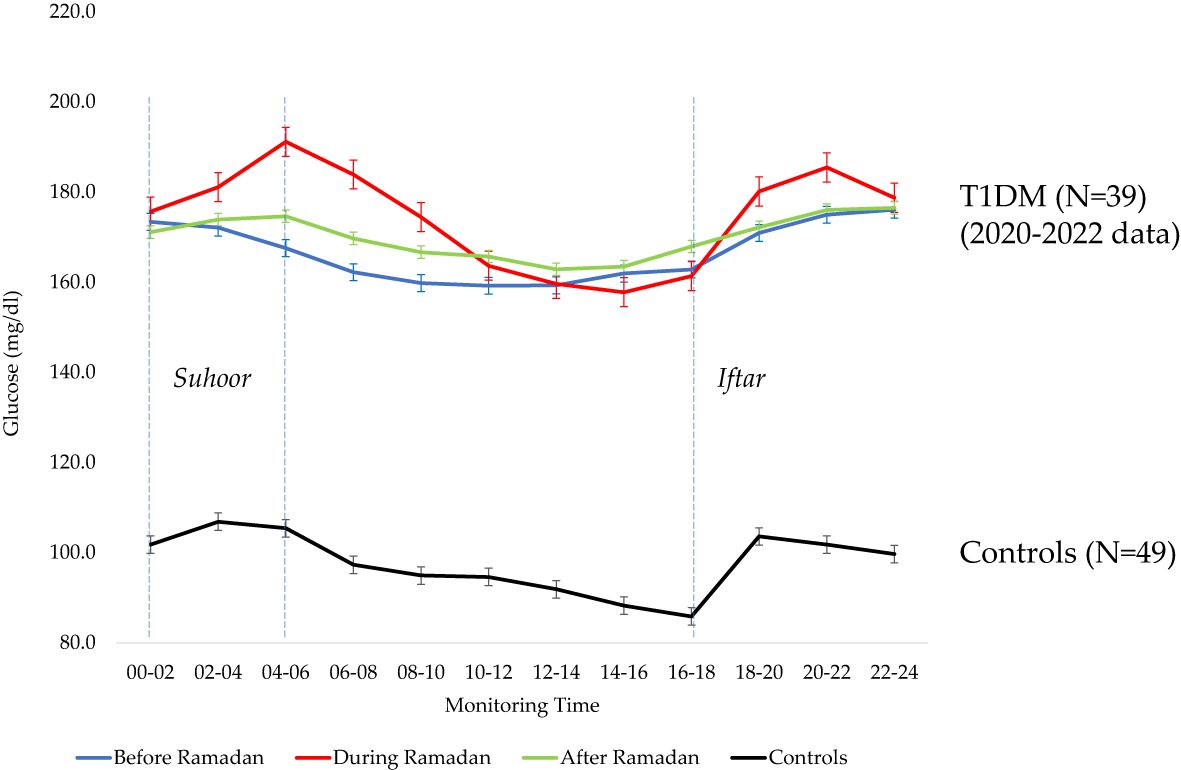
Figure 4. Pooled glycemic metrics of T1D participants before, during and after Ramadan versus Controls.
4 Discussion
In this real-world study, findings revealed a tendency for patients and/or their physicians to adopt an overprotective behavior to avoid hypoglycemia during Ramadan leading to an increase in time spent above the recommended glycemic range and a decrease in time spent within and below the target range. The pattern of glucose fluctuation (timing of the lowest and highest average glucose level) seen on FGM confirms the significant changes in lifestyle taking place during Ramadan in Saudi Arabia. The pattern of glucose levels during Ramadan, as observed in the present study, is consistent with previous studies (27–29). The average glucose levels slightly rise two hours before the Iftar meal, which could be attributed to the waning effect of the basal insulin dose and/or the increase in stress hormones due to prolonged fasting. Following the Iftar meal, there was a sharp increase in average glucose levels with a pronounced excursion that lasted for four hours, followed by a moderate decrease. The same pattern was observed after the Suhoor meal, with an increase in average glucose levels to the same extent and duration as the Iftar meal. During fasting, glucose levels gradually declined, reaching their lowest average at 14:00-16:00 h. This pattern was significantly different from that observed outside of Ramadan in several ways. First, the post-meal amplitude of glucose excursion during Ramadan was much higher. Second, there were higher fluctuations during Ramadan, and the difference between the lowest and highest average glucose was significantly greater. Third, contrary to the general assumption that TBR would be higher during Ramadan due to prolonged fasting (18), TBR was lower in this study in only the last year of the 3-year observation (2022). Consequently, GMI and TAR were all significantly higher during Ramadan than before and after of the same year.
The FGM data during Ramadan in healthy participants without T1D showed a similar pattern of glucose changes, albeit within normal, suggesting that the changes we are observing in patients with T1D is not only due to miscalculated/mismatched insulin requirement but also to the largely underestimated effect of cultural habits and diet taking place during Ramadan. As expected, not only the amplitude of postprandial hyperglycemia is greater in T1D patients, but also the duration of hyperglycemia which subjects patients with T1D to complications. The postprandial glucose excursion during Ramadan in healthy participants is similar to that reported in a previous study without Ramadan fasting (30). In patients with T1D, not only insulin management is important but also the effect of cultural diet on their glucose should be taken in consideration.
In the present study, the glucose trends during Ramadan exhibit the lowest average glucose levels between 14:00 to 16:00 h, which may be the time associated with a higher risk of hypoglycemia. Therefore, patients should be educated to frequently check their glucose levels during this time period, avoid strenuous physical activity, and respond immediately to any symptoms of hypoglycemia (27). It is highly important to bear in mind that patients living with T1D are prone to hypoglycemia unawareness. Previous research has found that patients with T1D spent an average of 1.39 hours per fasting day in hypoglycemia, with 8% of cases documented as severe yet asymptomatic (18).
The DAR-MENA T1D showed similar rates of confirmed and symptomatic hypoglycemia during Ramadan compared to before Ramadan (4). Other studies reported no increase in the time spent in hypoglycemia during Ramadan, but found no significant differences in terms of average glucose, GMI, or TAR (31–36). The present study found similar observations in the first 2 years of the study, with the final year showing significant differences in all time range indices. It is worthy to note that compared to years 2020 and 2021, most pandemic restrictions were lifted in Saudi Arabia from March 2022, a month before Ramadan, with all restrictions removed in June 2022. This complete removal of preventive measures that led to heightened social mobility, full opening of the fast food and dining industry, as well as outdoor recreational activities may have partially, but not fully explain, the differences observed in that year.
The present study results showed better glycemic control when compared to a previous study of glycemia during Ramadan in patients with T1D, which reported a TIR of 42%, TAR of 48%, and TBR of 10%. The study reached the same conclusion that there is a higher rate of hyperglycemia than hypoglycemia related to Ramadan fasting (27).
The unique addition of the current study is providing insight to what happens after Ramada. Although the values of the glycemic metrics improved during the month after Ramadan, they did not return to pre-Ramadan levels completely. Hence, fasting during Ramadan was associated with at least two months of disturbance in glycemic control, which highlights the need to reshape the conventional perception of Ramadan fasting as a risk factor for only hypoglycemia. More efforts and attention should made for the period after Ramadan not to prolong the duration spent in hyperglycemia.
The present study has some limitations. First, because this was a real-world study, we could not control or adjust dietary intake diversity among participants, which may have influenced our results. Second, we did not collect data on the timing and reasons for fast-breaking or hypoglycemic events, as well as insulin types used and day-to-day dose adjustments made. Finally, not all patients had complete data for the entire three-year period, but we reported estimated means and confidence intervals to illustrate the effect size of changes.
Despite these limitations, our study provides valuable insights into glucose profiles before, during, and after Ramadan fasting in adult patients with T1D using FGM. One of the strengths of this study is that it focused solely on patients with type 1 diabetes, young adults in particular, filling the needed data for an understudied population in T1D. Additionally, this study included patients’ data for three years, providing a more robust dataset.
The results of the current study have important clinical implications for patients with T1D and medical professionals alike since robust data for adults with T1D are scarce. Diabetes education and management strategies should be individualized and include diet and cultural habits for Ramadan, insulin dosing and timing tailored for Ramadan to help T1D patients safely fast, and counseling on after-Ramadan management.
5 Conclusions
This real-world observational study provided a unique and comprehensive look at the glycemic changes among young adults with T1D who attempted to fast before, during, and after Ramadan in SA, and revealed how Ramadan fasting can be associated with deterioration in glycemic control that starts during Ramadan and extends for at least one month afterwards. Attention should be directed to hyperglycemia during Ramadan and the month after Ramadan as well. A particular attention should be made to the underestimation of insulin requirements for Iftar and Suhoor meals and this may vary based on risk profile and history of overindulgent behavior during Ramadan.
Data availability statement
The raw data supporting the conclusions of this article will be made available by the authors, without undue reservation.
Ethics statement
The studies involving humans were approved by institutional review board, College of Medicine, King Saud University Riyadh, Saudi Arabia (Ref 21/0439/IRB). The studies were conducted in accordance with the local legislation and institutional requirements. Written informed consent for participation in this study was provided by the participants’ legal guardians/next of kin.
Author contributions
AMA: Conceptualization, Data curation, Investigation, Project administration, Resources, Supervision, Validation, Visualization, Writing – original draft, Writing – review & editing. EA: Data curation, Investigation, Resources, Writing – review & editing. AA: Data curation, Writing – review & editing. MA: Resources, Writing – review & editing. MA-S: Methodology, Resources, Visualization, Writing – review & editing.
Funding
The author(s) declare that no financial support was received for the research and/or publication of this article.
Conflict of interest
AMA has served on an advisory panel for Medtronic, Novonordisk, Eli Lilly, Vital Air, and Sanofi and has received honoraria for speaking from AstraZeneca, Eli Lilly, Medtronic, Novo Nordisk, and Sanof. AMA has received research support from AstraZeneca and Novo Nordisk and provided medical consultations to Eli Lilly. MA has served on an advisory panel for Eli Lilly, and Algorithm and has received honoraria for speaking from Eli Lilly, Novo Nordisk, Boehringer Ingelheim, and Sanofi. MA has received research support from Novo Nordisk. MA-S: has served on an advisory panel for Medtronic, Insulet, Abbott, VitalAire, Sanofi and has received honoraria for speaking from Abbott, Eli Lilly, Medtronic, Novo Nordisk, Sanofi, VitalAire; and provided medical consultations to Eli Lilly.
The remaining authors declare that the research was conducted in the absence of any commercial or financial relationships that could be construed as a potential conflict of interest.
Publisher’s note
All claims expressed in this article are solely those of the authors and do not necessarily represent those of their affiliated organizations, or those of the publisher, the editors and the reviewers. Any product that may be evaluated in this article, or claim that may be made by its manufacturer, is not guaranteed or endorsed by the publisher.
Supplementary material
The Supplementary Material for this article can be found online at: https://www.frontiersin.org/articles/10.3389/fendo.2025.1399990/full#supplementary-material
References
1. Ahmed SH, Chowdhury TA, Hussain S, Syed A, Karamat A, Helmy A, et al. Ramadan and diabetes: A narrative review and practice update. Diabetes Ther. (2020) 11:2477–520. doi: 10.1007/s13300-020-00886-y
2. Horne BD, Muhlestein JB, and Anderson JL. Health effects of intermittent fasting: hormesis or harm? A systematic review. Am J Clin Nutr. (2015) 102:464–70. doi: 10.3945/ajcn.115.109553
3. Santos HO and Macedo RCO. Impact of intermittent fasting on the lipid profile: Assessment associated with diet and weight loss. Clin Nutr ESPEN. (2018) 24:14–21. doi: 10.1016/j.clnesp.2018.01.002
4. Al Awadi FF, Echtay A, Al Arouj M, Sabir Ali S, Shehadeh N, Al Shaikh A, et al. Patterns of diabetes care among people with type 1 diabetes during ramadan: an international prospective study (DAR-MENA T1DM). Adv Ther. (2020) 37:1550–63. doi: 10.1007/s12325-020-01267-4
5. Eltoum N, Washi S, and Al Twaim A. Dietary habits and nutrients intake of diabetic adolescents during Ramadan fasting. Int J Food Nutr Public Health. (2014) 7:25–40. doi: 10.47556/J.IJFNPH.7.1.2014.3
6. Alamoudi R, Alsubaiee M, Alqarni A, Aljaser S, Saleh Y, Salam A, et al. Attitudes and habits of patients with type 1 diabetes during fasting Ramadan. J Clin Transl Endocrinol. (2018) 14:1–4. doi: 10.1016/j.jcte.2018.09.001
7. Bahijri S, Borai A, Ajabnoor G, Abdul Khaliq A, AlQassas I, Al-Shehri D, et al. Relative metabolic stability, but disrupted circadian cortisol secretion during the fasting month of Ramadan. PloS One. (2013) 8:e60917. doi: 10.1371/journal.pone.0060917
8. Ajabnoor GM, Bahijri S, Borai A, Abdulkhaliq AA, Al-Aama JY, and Chrousos GP. Health impact of fasting in Saudi Arabia during Ramadan: association with disturbed circadian rhythm and metabolic and sleeping patterns. PloS One. (2014) 9:e96500. doi: 10.1371/journal.pone.0096500
9. Deeb A, Elbarbary N, Smart CE, Beshyah SA, Habeb A, Kalra S, et al. ISPAD Clinical Practice Consensus Guidelines: Fasting during Ramadan by young people with diabetes. Pediatr Diabetes. (2020) 21:5–17. doi: 10.1111/pedi.12920
10. Hassanein M, Afandi B, Yakoob Ahmedani M, Mohammad Alamoudi R, Alawadi F, Bajaj HS, et al. Diabetes and ramadan: practical guidelines 2021. Diabetes Res Clin Pract. (2022) 185:109185. doi: 10.1016/j.diabres.2021.109185
11. Alshahrani M and Alraddadi A. Incidence of diabetic ketoacidosis during Ramadan compared with non-fasting months in King Saud Medical City, Riyadh, Saudi Arabia. J Family Med Prim Care. (2022) 11:3905. doi: 10.4103/jfmpc.jfmpc_2004_21
12. Salti I, Bénard E, Detournay B, Bianchi-Biscay M, Le Brigand C, Voinet C, et al. A population-based study of diabetes and its characteristics during the fasting month of Ramadan in 13 countries: results of the epidemiology of diabetes and Ramadan 1422/2001 (EPIDIAR) study. Diabetes Care. (2004) 27:2306–11. doi: 10.2337/diacare.27.10.2306
13. Loh HH, Lim LL, Loh HS, and Yee A. Safety of Ramadan fasting in young patients with type 1 diabetes: A systematic review and meta-analysis. J Diabetes Investig. (2019) 10:1490–501. doi: 10.1111/jdi.13054
14. Hassanein M, Alamoudi RM, Kallash MA, Aljohani NJ, Alfadhlu EM, Tony LE, et al. Ramadan fasting in people with type 1 diabetes during COVID-19 pandemic: The DaR Global survey. Diabetes Res Clin Pract. (2021) 172:108626. doi: 10.1016/j.diabres.2020.108626
15. Ibrahim M, Davies MJ, Ahmad E, Annabi FA, Eckel RH, Ba-Essa EM, et al. Recommendations for management of diabetes during Ramadan: update 2020, applying the principles of the ADA/EASD consensus. BMJ Open Diabetes Res Care. (2020) 8. doi: 10.1136/bmjdrc-2020-001248
16. Muammar T, Fojas EGF, Helal R, and Lessan N. Ramadan fasting among older children and adolescents with type 1 diabetes mellitus: A real-world study from the UAE. Front Nutr. (2022) 9:786678. doi: 10.3389/fnut.2022.786678
17. Al-Khawari M, Al-Ruwayeh A, Al-Doub K, and Allgrove J. Adolescents on basal-bolus insulin can fast during Ramadan. Pediatr Diabetes. (2010) 11:96–100. doi: 10.1111/j.1399-5448.2009.00544.x
18. Afandi B, Kaplan W, Majd L, and Roubi S. Rate, Timing, and Severity of hypoglycemia in adolescents with Type 1 diabetes during ramadan fasting: A study with freestyle libre flash glucose monitoring system. Ibnosina J Med Biomed Sci. (2018) 10:9–11. doi: 10.4103/ijmbs.ijmbs_73_17
19. Alguwaihes AM, Alotaibi N, Alotaibi M, Masry N, and Safarini S. The use of miniMed780G system is associated with stable glycemic control in people with type 1 diabetes before, during, and after ramadan: an observational study. J Diabetes Res. (2025) 2025:4144787. doi: 10.1155/jdr/4144787.19
20. Tootee A and Larijani B. Ramadan fasting and diabetes, latest evidence and technological advancements: 2021 update. J Diabetes Metab Disord. (2021) 20:1003–9. doi: 10.1007/s40200-021-00804-4
21. Al-Ozairi E, El Samad A, Al Kandari J, and Aldibbiat AM. Intermittent fasting could be safely achieved in people with type 1 diabetes undergoing structured education and advanced glucose monitoring. Front Endocrinol (Lausanne). (2019) 10:849. doi: 10.3389/fendo.2019.00849
22. Hassanein M, Abdelgadir E, Bashier A, Rashid F, Saeed MA, and Khalifa A. The role of optimum diabetes care in form of Ramadan focused diabetes education, flash glucose monitoring system and pre-Ramadan dose adjustments in the safety of Ramadan fasting in high risk patients with diabetes. Diabetes Res Clin Pract. (2019) 150:288–95. doi: 10.1016/j.diabres.2018.12.013
23. Al-Agha AE, Kafi SE, Zain Aldeen AM, and Khadwardi RH. Flash glucose monitoring system may benefit children and adolescents with type 1 diabetes during fasting at Ramadan. Saudi Med J. (2017) 38:366–71. doi: 10.15537/smj.2017.4.18750
24. Alamoudi R, Alsubaiee M, Alqarni A, Saleh Y, Aljaser S, Salam A, et al. Comparison of insulin pump therapy and multiple daily injections insulin regimen in patients with type 1 diabetes during ramadan fasting. Diabetes Technol Ther. (2017) 19:349–54. doi: 10.1089/dia.2016.0418
25. Bailey T, Bode BW, Christiansen MP, Klaff LJ, and Alva S. The performance and usability of a factory-calibrated flash glucose monitoring system. Diabetes Technol Ther. (2015) 17:787–94. doi: 10.1089/dia.2014.0378
26. Battelino T, Danne T, Bergenstal RM, Amiel SA, Beck R, and Biester T. Clinical targets for continuous glucose monitoring data interpretation: recommendations from the international consensus on time in range. Diabetes Care. (2019) 42:1593–603. doi: 10.2337/dci19-0028
27. Alfadhli EM. Higher rate of hyperglycemia than hypoglycemia during Ramadan fasting in patients with uncontrolled type 1 diabetes: Insight from continuous glucose monitoring system. Saudi Pharm J. (2018) 26:965–9. doi: 10.1016/j.jsps.2018.05.006
28. Teoh ST, Hussain S, and Hong JYH. Glycaemic changes among children and adolescents with type 1 diabetes mellitus before and during ramadan fasting using continuous glucose monitoring. J ASEAN Fed Endocr Soc. (2022) 37:49–59. doi: 10.15605/jafes.037.02.08
29. Lessan N, Hannoun Z, Hasan H, and Barakat MT. Glucose excursions and glycaemic control during Ramadan fasting in diabetic patients: Insights from continuous glucose monitoring (CGM). Diabetes Metab. (2015) 41:28–36. doi: 10.1016/j.diabet.2014.11.004
30. González-Rodríguez M, Pazos-Couselo M, García-López JM, Rodríguez-Segade S, Rodríguez-García J, Túñez-Bastida C, et al. Postprandial glycemic response in a non-diabetic adult population: the effect of nutrients is different between men and women. Nutr Metab (Lond). (2019) 16:46. doi: 10.1186/s12986-019-0368-1
31. Kaplan W, Afandi B, Al Hassani N, Hadi S, and Zoubeidi T. Comparison of continuous glucose monitoring in adolescents with type 1 diabetes: Ramadan versus non-Ramadan. Diabetes Res Clin Pract. (2017) 134:178–82. doi: 10.1016/j.diabres.2017.10.010
32. Al Hayek AA, Robert AA, and Al Dawish MA. Evaluating the impact of Ramadan fasting on ambulatory glucose profile among patients with type 1 diabetes using Flash Glucose Monitoring System: A comparative study. Diabetes Metab Syndr. (2022) 16:102472. doi: 10.1016/j.dsx.2022.102472
33. Alawadi F, Alsaeed M, Bachet F, Bashier A, Abdulla K, and Abuelkheir S. Impact of provision of optimum diabetes care on the safety of fasting in Ramadan in adult and adolescent patients with type 1 diabetes mellitus. Diabetes Res Clin Pract. (2020) 169:108466. doi: 10.1016/j.diabres.2020.108466
34. Yan J, Zhou Y, Zheng X, Zheng M, Lu J, and Luo S. Effects of intermittently scanned continuous glucose monitoring in adult type 1 diabetes patients with suboptimal glycaemic control: A multi-centre randomized controlled trial. Diabetes Metab Res Rev. (2023) 39:e3614. doi: 10.1002/dmrr.3614
35. Marcovecchio ML. Complications of acute and chronic hyperglycemia. US Endocrinol. (2017) 13:17. doi: 10.17925/USE.2017.13.01.17
Keywords: Ramadan, intermittent fasting, type 1 diabetes, Saudi Arabia, flash glucose monitoring, continuous glucose monitoring
Citation: Alguwaihes AM, Alyusuf EY, Alrajeh A, Alotaibi M and Al-Sofiani ME (2025) Altered Ramadan fasting glycemic profiles of adults with type 1 diabetes reveal strong evidence of underestimated insulin adjustments: a 3-year observational study in Arab settings. Front. Endocrinol. 16:1399990. doi: 10.3389/fendo.2025.1399990
Received: 12 March 2024; Accepted: 06 May 2025;
Published: 29 May 2025.
Edited by:
Åke Sjöholm, Gävle Hospital, SwedenReviewed by:
Tarik A. A. A. Elhadd, Hamad Medical Corporation, QatarRayaz A. Malik, Weill Cornell Medicine, Qatar
Copyright © 2025 Alguwaihes, Alyusuf, Alrajeh, Alotaibi and Al-Sofiani. This is an open-access article distributed under the terms of the Creative Commons Attribution License (CC BY). The use, distribution or reproduction in other forums is permitted, provided the original author(s) and the copyright owner(s) are credited and that the original publication in this journal is cited, in accordance with accepted academic practice. No use, distribution or reproduction is permitted which does not comply with these terms.
*Correspondence: Abdullah M. Alguwaihes, YWFsZ3V3YWloZXNAa3N1LmVkdS5zYQ==
 Abdullah M. Alguwaihes
Abdullah M. Alguwaihes Ebtihal Y. Alyusuf
Ebtihal Y. Alyusuf Areej Alrajeh4
Areej Alrajeh4